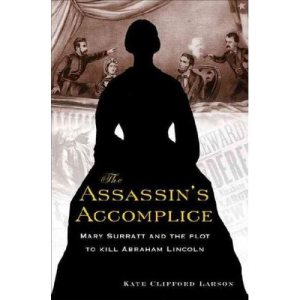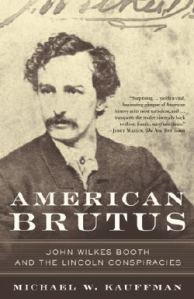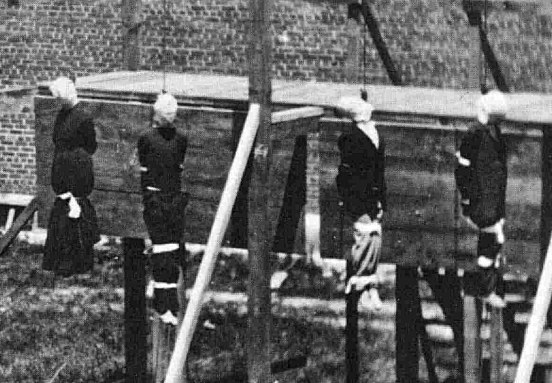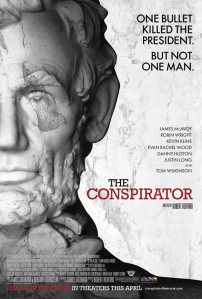From the moment that the American Film Company released The Conspirator, questions have been raised about the films accuracy regarding the lead counsel, Frederick Aiken. Was he, as FoxNews host Bill O’Reilly would opine, a “pinhead” or a “patriot?” You be the judge.
Little has been written about Frederick Aiken. This Week in the Civil War posted some preliminary materials back in April, and they it still seems to be the only biographical material out there. You can read the biography post here.
The mystery goes even deeper than that. The owner of this blog made a records request for Aiken’s personnel files from the National Archives earlier this year. Instead of receiving a packet with all the mundane details of his assignments and pay records, the most Civil War personnel files contain, the Archives sent back one sheet of paper that said, “Record not located.”
The life of Frederick Aiken is still a mystery. Perhaps someday we’ll know more about his story but until then, we’ll dig up every rudimentary detail that we can find.
In the meantime, the Surratt House Museum website has an index of .pdf files on the trial that you can download here. It would be a great place to start your own research into the career of Frederick Aiken.
Two key books were written that details the Assassination of President Lincoln, with suitable references to the young attorney. I highly recommend you purchase a copy of each book in order to understand the context of the quotations. (For the record, I do not have any financial interest in either of these books.)
 The first one is Assassin’s Accomplice by Dr. Kate Clifford Larsen, from which the film, The Conspirator, was based upon.
The first one is Assassin’s Accomplice by Dr. Kate Clifford Larsen, from which the film, The Conspirator, was based upon.
By the close of court on May 10, the rest of the defendants were still without counsel. Mudd’s lawyer, Brent, backed out, so the following day, Mudd petitioned the court for change of counsel to Frederick Stone, Herold’s lawyer. Mary arrived in court with new counsel as well: Frederick Aiken and John W. Clampitt, the new associates in Reverdy Johnson’s large practice in Washington. Aiken, born and raised in Massachusetts, had passed the bar in Vermont and was very active in Democratic Party politics. During the war he had worked as a correspondent for the New York Times, and had been practicing law only a short time when he was called upon to help defend Surratt. Clampitt was a Washingtonian, and had only recently begun practicing law with Aiken in Johnson’s law office. He, too, was an active Democratic Party loyalist. Johnson, in the meantime, would remain Mary’s lead counsel, in spite of his own heavy case load. [pg. 145]
On Friday, May 12, the court reconvened at ten o’clock in the morning. Sam Arnold had successfully retained counsel: General Thomas Ewing Jr., a Union officer and successful Washington lawyer. He would represent not only Arnold, but Ed Spangler and Samuel Mudd, too, as co-counsel with Frederick Stone. Michael O’Laughlen hired Walter S. Cox, a local attorney and professor at Columbia College, who would also assist Stone with Arnold’s defense. George Atzerodt’s family retained William E. Doster for him. Doster had been a former provost marshall in Washington, and would prove to be a contentious defense counsel. The court would prevail upon him to take Payne on as a client, too, after Payne’s first lawyer backed out and no other was willing to represent him. [pg. 145]
Whether Johnson ultimately decided that Mary as guilty or not remains unknown. However, within a few days, Johnson rarely appeared in court, leaving Mary’s defense to his inexperienced associates Clampitt and Aiken. [pp. 146-147]
After Weichmann and Lloyd’s extensive testimonies, Reverdy Johnson virtually gave up on Mary’s defense. His absence was duly noticed. Rumors began spreading that Johnson knew Mary was guilty and had therefore deserted her. As early as May 16, the Philadelphia Inquirer reported that Johnson “had abandoned cross-questioning the witnesses, and is preparing an argument to prove that the court cannot try these cases, for lack of power.” Johnson’s decision to not appear regularly in court as part of Mary’s defense team, and to leave her in the hands of his inexperienced associates, Frederick Aiken and John Clampitt, would have tragic consequences. [pg. 154]
Almost every day, further negative testimony implicated Mary and her son John ever more deeply in Booth’s plans. Reverdy Johnson’s new associates, Aiken and Clampitt, now without their experienced lead counsel, seemed helpless to stem the flow of damaging evidence. [pg. 155]
Mary’s co-council Frederick Aiken announced to the court that the defendants’ attorneys had met privately to discuss the order of presentation. They agreed that testimony relating to Mrs. Surratt would launch the first phase of the defense of the conspirators. [pg. 156]
When cross-examined by Judge Holt, Eliza noted that Mrs. Surratt never appeared to have difficulty recognizing people by gaslight in the parlor. Aiken’s efforts to bolster Mary’s claim that poor eyesight and dim light had prevented her from recognizing Payne on the night of her arrest were ineffectual. The day had not gone well for Mary’s defense. [pg. 158]
Mary’s defense had taken a beating. By the time court adjourned that Saturday afternoon, Aiken and Clampitt had only succeeded in making the prosecution’s case even stronger. Even at this early date, Mary’s prospects looked bleak. Clampitt and Aiken needed to regroup. They returned to court on Monday ready to take a different tack. [pg. 169]
It would be another two days before Aiken and Clampitt would provide their own closing summation, even though Johnson knew that they were inexperienced attorneys and it could prove disastrous to leave Mary’s final defense arguments in their hands. Just as he did through most of the trial, he left Mary’s life – and left Mary’s life in their hands. [pg. 190]
 The other book is American Brutus by Michael W. Kauffman.
The other book is American Brutus by Michael W. Kauffman.
The defendants were still scrambling to find lawyers, and in a short time most of the accused had found someone. John Atzerodt hired William E. Doster, the former provost marshal of Washington, to represent his brother. Walter S. Cox, a law professor at Columbian College, agreed to defend O’Laughlen, and David Herold retained the services of Frederick Stone, from a distinguished Charles County famliy. Dr. Mudd and Sam Arnold would both be represented by General Thomas Ewing, Jr., former chief justice of the Kansas Supreme Court and a brother-in-law of General William T. Sherman. All were fine attorneys, but there were not enough to go around. Spangler and Powell were still unrepresented and after several rejections, Mary Surratt could secure only the services of two neophytes, John W. Clampitt and Frederick A. Aiken. Neither had experience in a capital case, and Aiken was just completing his first year of practice. [pg. 340]
Many of the objections raised by Frederick Aiken, the attorney for Mary Surratt, would have been overruled in any court. Aiken was not an experienced lawyer. He did not understand the rules of evidence, and his frequent missteps played as heavily against his client as anything the commission decided. He rarely came prepared and often failed to anticipate what his own witnesses would say…Perhaps Aiken’s worst blunder was calling Augustus Howell to the stand. Howell was defiant, evasive, and inordinately proud of his opposition to the Yankees. His testimony was intended to cast suspicion on Weichmann, whom he had taught to use a Confederate cipher machine but it only called attention to the fact that Howell himself knew how to use the device. [pp. 357-358]
In an exchange with Lew Wallace, Aiken admitted that the process was not at fault. The general said “I understood the object of the counsel to be, to impeach not only the witness for the government, but also the fairness of the Court.” To this, Aiken replied, “No, sir; only the witness; not the fairness of the Court at all. I have no reason to complain of that. None of us have had.”[pg. 358]

The Assassination Conspirators Hang - from left: Mary E. Surratt, Lewis Powell, George Atzerodt, David Herold. Photo by Alexander Gardner.
You be the judge. Was Aiken a “pinhead” for representing Surratt in the first place, and setting himself up for the inevitable fall that would occur if/when she was found guilty? Or was he a “patriot” for undertaking a task that he knew might be ruinous to his future career? The one thing that we know for sure is that Frederick Aiken was a victim of his own inexperience as an attorney.



Pingback: Colonel Frederick A. Aiken biography | thisweekinthecivilwar
If you are interested in reading more about Frederick Aiken, you may contact me or Laurie Verge at the Surratt House Museum and we will send you a copy of an article, “Finding Frederick” I wrote about Aiken which was published in the Surratt Courier and later in the Lincoln Herald (both in 2011).
Aiken is a fascinating man and researching him has been quite an adventure; just when I think I’m done something else interesting turns up to paint a clearer (or sometimes muddier) picture of him. My latest discovery is his spy activities (for Seward) early in the war!
I would really like to learn more about Frederick Aiken. Thank you so very much
I would like to obtain a copy of the article you wrote concerning Frederick Aiken. If you can send it electronically, please do so. If it is by mail, please advise and I’ll give you an address and pay any costs.
Thanks
David Boyd
If you go to http://www.surratt.org/ and click on the link “Finding Frederick” you’ll find Christine’s article. I just haven’t had time to make a post about it quite yet.
Pingback: Lincoln Assassination Resources | This Week in the Civil War
I’d like to learn more about Mr. Aiken. Thanks, Larry
Would like to learn more about Mary surratt
You can read the Mary Surratt biographical sketch here http://thisweekinthecivilwar.com/?p=308